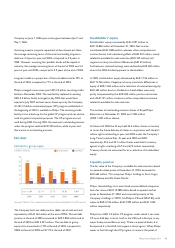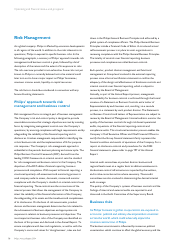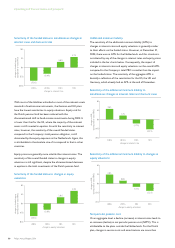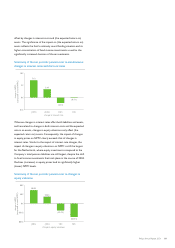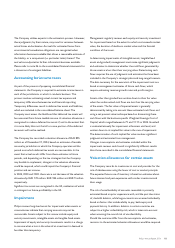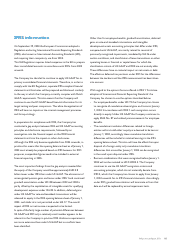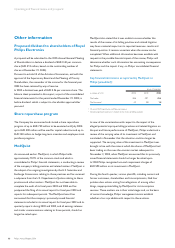Philips 2004 Annual Report Download - page 83
Download and view the complete annual report
Please find page 83 of the 2004 Philips annual report below. You can navigate through the pages in the report by either clicking on the pages listed below, or by using the keyword search tool below to find specific information within the annual report.Critical Accounting Policies
The preparation of Philips’ financial statements requires us to
make estimates and judgments that affect the reported amounts of
assets and liabilities, revenues and expenses, and related disclosure
of contingent assets and liabilities at the date of our financial
statements. The policies that management considers both to be
most important to the presentation of Philips’ financial condition
and results of operations and to make the most significant
demands on management’s judgments and estimates about matters
that are inherently uncertain are discussed below. Management
cautions that future events often vary from forecasts and that
estimates routinely require adjustment.
A complete description of Philips’ accounting policies appears on
pages 97 to 104.
Accounting for pensions and other
postretirement benefits
Retirement benefits represent obligations that will be settled in
the future and require assumptions to project benefit obligations.
Retirement benefit accounting is intended to reflect the
recognition of future benefit costs over the employee’s
approximate service period, based on the terms of the plans and
the investment and funding decisions made by the Company. The
accounting requires management to make assumptions regarding
variables such as discount rate, rate of compensation increase,
return on assets, and future healthcare costs. Management
consults with outside actuaries regarding these assumptions at
least annually. Changes in these key assumptions can have a
significant impact on the projected benefit obligations, funding
requirements and periodic cost incurred.
For a discussion of the current funded status and a sensitivity
analysis with respect to pension plan assumptions, please refer to
note 20 of the consolidated financial statements. For a sensitivity
analysis with respect to changes in the assumptions used for
postretirement benefits other than pensions, please refer to note
21 of the consolidated financial statements.
Contingent liabilities
Legal proceedings covering a range of matters are pending in
various jurisdictions against the Company and its subsidiaries. Due
to the uncertainty inherent in litigation, it is often difficult to
predict the final outcome. The cases and claims against the
Company often raise difficult and complex factual and legal issues
which are subject to many uncertainties and complexities,
including but not limited to the facts and circumstances of each
particular case and claim, the jurisdiction in which each suit is
brought and the differences in applicable law. In the normal course
of business, management consults with legal counsel and certain
other experts on matters related to litigation. The Company
accrues a liability when it is determined that an adverse outcome is
probable and the amount of the loss can be reasonably estimated.
If either the likelihood of an adverse outcome is only reasonably
possible or an estimate is not determinable, the matter is disclosed
provided it is material.
Judicial proceedings have been brought in the United States,
relating to the activities of a subsidiary prior to 1981, involving
allegations of personal injury from alleged asbestos exposure. The
claims generally relate to asbestos used in the manufacture of
unrelated companies’ products in the United States and frequently
involve claims for substantial general and punitive damages.
The methodology used to determine the level of liability requires
significant judgments and estimates regarding the costs of settling
asserted claims. The estimated liability is established based upon
recent settlement experience for similar types of claims. In
situations where the exact type and the extent of the alleged
illness is not yet known, the accrual for loss contingencies is
established based upon a ‘low end of range’ estimate.
The resolution of each case is generally based upon
claimant-specific information, much of which is not available until
shortly before the scheduled trail date. Accordingly, variances
between the actual and estimated costs of settlements may occur.
The Company cannot reasonably predict the number of claims
that may be assessed in the future. Accordingly, an estimated
liability with respect to unasserted claims has not been recorded.
The Company and its subsidiaries are subject to environmental
laws and regulations. Under these laws, the Company and its
subsidiaries may be required to remediate the effects of the
release or disposal of certain chemicals on the environment.
The methodology for determining the level of liability requires a
significant amount of judgment regarding assumptions and
estimates. In determining the accrual for losses associated with
environmental remediation obligations, such significant judgments
relate to the extent and types of hazardous substances at a site,
the various technologies that may be used for remediation, the
standards of what constitutes acceptable remediation, the relative
risk of the environmental condition, the number and financial
condition of other potentially responsible parties, and the extent
of the Company’s and/or its subsidiaries’ involvement.
82 Philips Annual Report 2004
Operating and financial review and prospects



